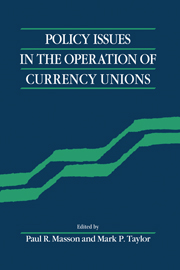Book contents
- Frontmatter
- Contents
- List of contributors
- Preface
- I Assessing the literature
- II Existing currency unions
- III Is Europe an optimum currency area?
- IV EMU: The road from Maastricht
- 8 The European System of Central Banks after Maastricht
- 9 A European money demand function
- 10 Monetary union and fiscal union: a perspective from fiscal federalism
- Index
10 - Monetary union and fiscal union: a perspective from fiscal federalism
from IV - EMU: The road from Maastricht
Published online by Cambridge University Press: 04 August 2010
- Frontmatter
- Contents
- List of contributors
- Preface
- I Assessing the literature
- II Existing currency unions
- III Is Europe an optimum currency area?
- IV EMU: The road from Maastricht
- 8 The European System of Central Banks after Maastricht
- 9 A European money demand function
- 10 Monetary union and fiscal union: a perspective from fiscal federalism
- Index
Summary
Introduction
The theory of optimal currency areas seeks to determine the optimal geographical domain of a currency. The theory of fiscal federalism seeks to determine the optimal regional organization of government within the boundaries of a geographical area. The former starts from the presumption that one money, administered by a single monetary authority, should circulate in a region. The latter holds that the authority over fiscal policy should be divided between governments of various regional levels, each with its own functions and responsibilities. Thus, the theory of optimal currency areas embodies a paradigm of centralizing policy functions, fiscal federalism embodies a paradigm of decentralized government.
The modern version of the theory of optimal currency areas lists a variety of criteria for choosing the size of a currency area or monetary union. In a nutshell, the benefits from monetary union result from the lower costs of transactions in international trade with one money or completely fixed exchange rates, from the implementation of a common monetary policy in response to exogenous shocks, and, provided that the institutional design of the monetary union's central bank is right, from a more credible central bank commitment to price stability. The main costs associated with monetary union result from the loss of the exchange rate as an instrument of macroeconomic adjustment. These costs will be small, if the size of transitory, country-specific shocks within the union is small compared to common shocks and permanent shocks, if capital and labor mobility are high within the union, and if the majority of the members' trade occurs with other members of the monetary union.
- Type
- Chapter
- Information
- Policy Issues in the Operation of Currency Unions , pp. 264 - 296Publisher: Cambridge University PressPrint publication year: 1993
- 11
- Cited by



